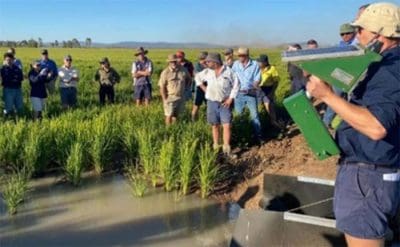
Deakin University PhD candidate Matt Champness in his field of rice research. Photo: Matt Champness.
A RESEARCH project is trialing new telecommunication tools to help New South Wales rice growers become more efficient with their water usage and potentially save labour costs.
Deakin University PhD candidate Matt Champness’ research is combining remote sensing technology and new telecommunication methods to find that ‘sweet spot’ between minimum amount of soil moisture needed before yield is compromised.
“This is about maximising your water productivity – and use of technology is key,” Mr Champness said.
“My research applies infield and remote-sensing technology to the aerobic rice growing system to reduce water use.
“The results are looking promising.”
Mr Champness is working under the Smart Irrigation Control for Water and Labour Savings in Rice project.
“The aerobic rice-growing system involves direct drilling the rice into the ground.
“Instead of keeping the crop ponded for long periods of time, it’s flushed regularly with water.
“This drastically reduces the amount of water used to produce a crop.
“Traditional drill-sown rice has 3 water flushes – or waterings – per season, to establish it.
“Then the rice paddy is flooded permanently for a longer period.
“We are trialling aerobic rice in a commercial setting aimed at using less water than traditional rice cultures.
“It’s much more labour intensive as the farmer needs to manually perform around 30 flushes per paddy per season.
“Working out exactly when to water to get that ‘sweet spot’ effect is not currently known.
“Aerobic rice has been proven across the world to save water.
“However, it comes at substantial yield risk and is not currently profitable in our environment due to reduced yields and high labour costs.”

Researchers demonstrating to rice growers how technology research can help them use much less water. Photo: Matt Champness.
Potential labour savings
Mr Champness said creating irrigation triggers could reduce the yield issues and labour costs associated with aerobic rice.
“I’m looking into irrigation triggers for aerobic rice to help give farmers confidence on when to irrigate, with automation enabling irrigation to occur while farmers are conducting other farm duties.
“Automation has the potential to save a lot of labour, decrease farmer safety issues, and increase water efficiency.
“Flushing can be controlled using an app on a phone from nearly anywhere, even on holidays.
“However, depending on mobile or Wi-Fi coverage, service isn’t always reliable.
“I’ve found using low-frequency radio signal to communicate between the farmer and their irrigation infrastructure works very well.
“Working with commercial growers and providers of automated irrigation systems to refine the technology for use in commercial settings has proven commercial aerobic rice production is doable.
“Trials have been undertaken at De Bortoli Wines in Griffith where they also grow rice as a broadacre crop.
“The main trial investigating various irrigation thresholds has had good results with 1.6 tonnes of rice grown per megalitre of water.
“With some nitrogen treatments, yields have exceeded 2.2 tonnes per megalitre, well above the current industry average of 1 tonne per megalitre.”
The Smart Irrigation Control for Water and Labour Savings in Rice project is co-funded by the Australian Government from the Rural Research and Development for-Profit Program, Deakin University and AgriFutures.
Source: Murray–Darling Basin Authority

HAVE YOUR SAY